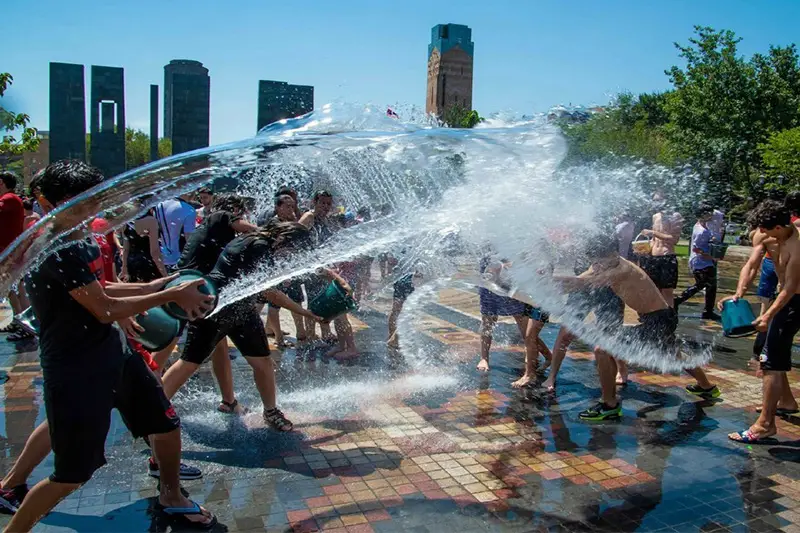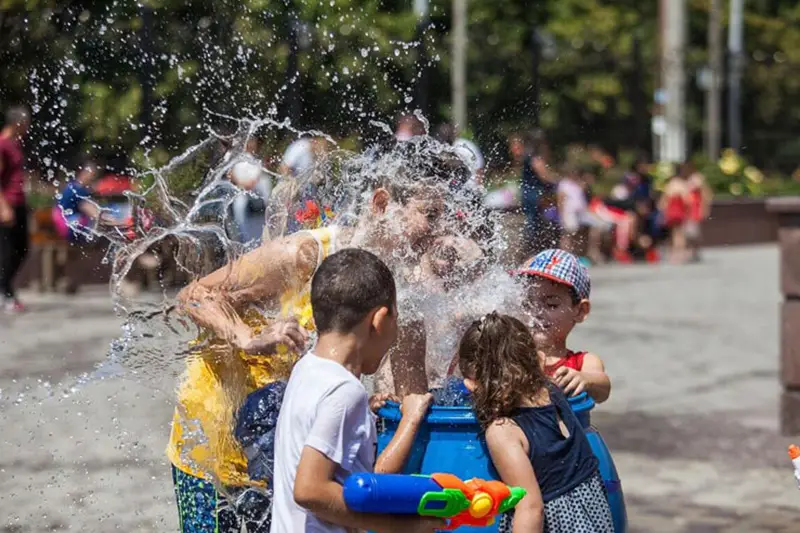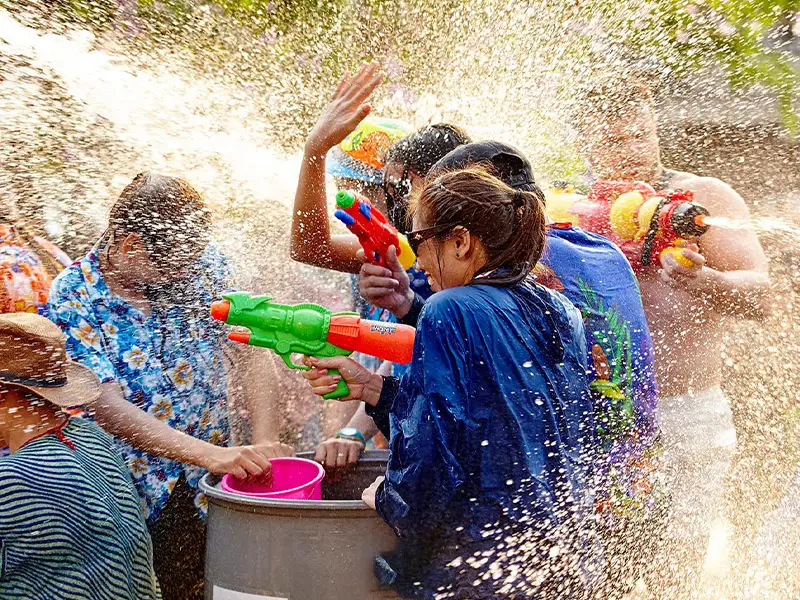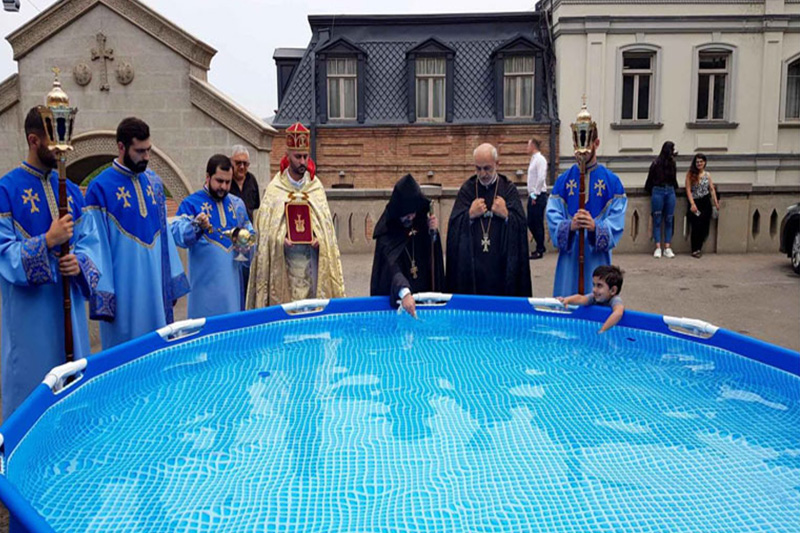
وبلاگ سپهران | Festivals | Armenia Water Festival
Imagine walking through a city in the middle of summer, under the heat of July and August, when suddenly water is splashed on you from every direction — not as a prank, but as part of a national celebration! This is not a movie scene; it’s a real annual event in Armenia. Vardavar, also known as the Armenia Water Festival, is one of the country’s oldest traditions — a celebration rooted in ancient mythology that has evolved into a joyful, global-style festival. On this day, regardless of age, status, or whether you are a local or a tourist, there is only one rule: “Get wet and smile!”
Suppose you’re looking for a unique trip, an exciting cultural experience, and a chance to feel the real spirit of the Armenian people. In that case, Vardavar is the event you should mark on your travel calendar.
Vardavar is the biggest water festival in Armenia — a tradition that dates back centuries and has now become a joyful public celebration. It is held 14 weeks after Easter, on one of the hottest days of July. Children, young people, and even the elderly take to the streets with buckets, water guns, hoses, or anything that can splash water — and everyone gets soaked without hesitation. On the day of the festival, there is no line between observer and participant — anyone walking outside may suddenly get a bucket of cold water dumped on their head from a balcony! Even firefighters join in with high-pressure hoses, turning the streets into one giant water playground. So if you are in Yerevan or any other Armenian city during this time, dress comfortably and be ready to get wet — because no one stays dry on Vardavar day!
Although the summer heat is a good excuse for a water festival, Vardavar’s roots are much deeper. The celebration originated in ancient Armenian pagan traditions and was later adopted into Christian culture. Vardavar symbolises purification, joy, fertility, and the renewal of life, and it remains culturally important to Armenians today.

Vardavar is one of the oldest Armenian traditions, dating back to pre-Christian times. In ancient Armenian belief, the festival was dedicated to Astghik, the goddess of love, beauty, fertility, and water. The word “Vardavar” comes from “vard,” meaning rose, which was the symbol of Astghik. The second part, “var,” means to sprinkle, to pour, or to rise. Together, the name refers to “sprinkling roses” or “the festival of water and flowers.”
With the arrival of Christianity, many pagan rituals disappeared — but Vardavar survived in a new form. The Church reinterpreted the festival as a celebration of the Transfiguration of Christ, and the act of water-splashing symbolised purification, forgiveness, and washing away sins. Yet the joyful spirit of the festival never changed, and Vardavar remains one of the most beloved public celebrations in Armenia.
Even though its meaning changed through history, the ancient name survived. That’s because Vardavar is not just a religious event — it is a cultural identity. The festival has always represented a blend of mythology, nature, water, love, and life, and this deep cultural root kept the original name alive.
Today, Vardavar is not only celebrated by Armenians, but tourists from all over the world travel to Armenia to experience it. On this day, no one stays dry, and nobody asks for permission before splashing water on you — water is the universal language of fun!

To join the excitement of Vardavar, you must travel to Armenia in July, when the festival takes place. There are several travel options, and the right one depends on your time, budget, and travel style.
If you enjoy road trips, you can enter Armenia by land. This can be done either by bus or private car.
Direct buses from Tehran to Yerevan can be booked from Terminal-e Gharb (Azadi) and Terminal-e Beyhaqi (Argentina) in Tehran. Terminal-e Azadi usually has more departures, so the chance of finding a ticket for your preferred date is higher. All buses arrive in Yerevan, and ticket prices vary depending on bus type and services provided.
If you prefer driving, head toward the Norduz border crossing in East Azerbaijan Province. Since the trip is long, bring water, snacks, and road-trip essentials.
Suggested route from Tehran to Yerevan (approximate):
| Route | Distance | Driving Time |
|---|---|---|
| Tehran → Tabriz | 624 km | 6.5 hours |
| Tabriz → Jolfa | 139 km | 1 hour 20 min |
| Jolfa → Siah-Rud | 47 km | 50 min |
| Siah-Rud → Norduz Border | 62 km | 1 hour 10 min |
| Norduz → Yerevan | 383 km | ~7 hours 15 min |
After crossing the border, there is still a long drive ahead before reaching Yerevan — and eventually the lively, water-filled streets of the festival.
If time matters and you don’t want long road hours, flying to Yerevan is the best choice. Flights from Tehran to Yerevan usually fall into three categories:
| Type of Flight | Duration |
|---|---|
| Direct flight | ~1 hour 30 min |
| One stop | 5+ hours |
| Multiple stops | 8+ hours |
The more direct the flight, the higher the cost — so the choice depends on budget and urgency.
If you prefer not to deal with planning routes, hotels, or scheduling, tour packages for Vardavar are an easy solution. Ground tours usually cross the Norduz border and end in Yerevan. Prices vary depending on services, duration, transportation type, and departure city.

Traveling to Armenia is visa-free for Iranian citizens, meaning a valid passport is enough. However, you should consider the following:
| Required Item | Notes |
|---|---|
| Passport | At least 6 months validity on the departure date |
| Round-trip ticket | For air travel (may be checked at airport) |
| Travel insurance | Not mandatory, but strongly recommended |
| International driver’s license | Required if driving your own car |
| Vehicle documents + Carnet (Kapotazh) | For legally exiting the country with a private car |
If you are traveling with a bus or tour, most paperwork is handled by the agency.

Vardavar is a completely free and spontaneous water celebration — so be prepared!

If you prefer to observe or take photos from a good spot, these locations are usually the most lively:
| Location | Why it’s ideal |
|---|---|
| Republic Square | Main city center, largest crowds |
| Yerevan Cascade | Wide space, stone steps, great city view |
| Lovers’ Park | Family-friendly, calmer area |
| Swan Lake | Popular for young people & group water fights |
| Northern Avenue | Shopping street, cafes, tourist-friendly |
To capture the best shots at Vardavar, keep these tips in mind:

The festival day begins early in the morning with religious ceremonies in Armenian churches, celebrating the Transfiguration of Christ. After that, priests perform a blessing ritual on water and seasonal fruits — especially apples, which symbolize fertility and abundance.
Once the church ritual ends, the joyful public celebration begins throughout the city. You will see:
And finally, the highlight: the mass water-splashing, when everyone takes to the streets and the real festival begins. There is no difference between audience and participants — everyone becomes part of the celebration.
The Armenia Water Festival is more than just a playful water-splashing event; it is a bridge between ancient mythology, Christian symbolism, and modern collective joy. It proves that traditions, when kept alive with the spirit of the people, can survive centuries and still bring happiness to today’s world.
Vardavar lets you experience the authentic culture of Armenia, where love, beauty, purity, and friendship flow in the form of water. If you’re looking for a trip that goes beyond sightseeing and turns into a living, unforgettable experience, the Armenia Water Festival is the perfect choice.
So if you plan to travel in the summer of 2025, don’t just think about cooling off — be ready to get soaked, laugh, and witness one of the most unique festivals in the world.